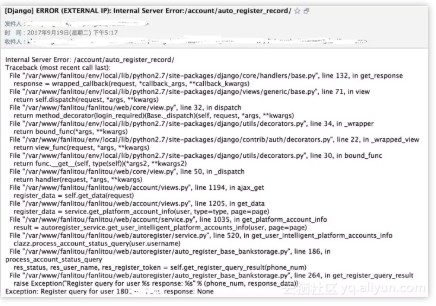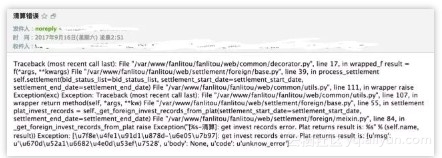话不多说,直入正题。
先上图,看一下监控的效果。
如下是监控我们网站系统错误的邮件。包含了请求的url地址,以及详细的异常信息。

一、监控所有的request请求
如何实现系统监控,自动发送错误日志的邮件呢?只需配置配置settings文件即可。
1.设置发送邮件配置信息
邮件会发送到ADMINS设定的邮件列表中。
SERVER_EMAIL ='[email protected]'
DEFAULT_FROM_EMAIL ='[email protected]'
ADMINS = (('receiver','[email protected]'),)
EMAIL_HOST ='smtp.exmail.qq.com'
EMAIL_HOST_USER ='[email protected]'
EMAIL_HOST_PASSWORD ='123456'
EMAIL_BACKEND = 'django.core.mail.backends.smtp.EmailBackend'2.配置LOGGING
1)配置mail_admin的handler
level为日志级别
django.utils.log.AdminEmailHandler为django处理系统日志发送邮件的handler
在没有配置filter参数情况下,默认发送系统5XX状态的错误日志
'handlers': {
'mail_admin': {
'level':'ERROR',
'class':'django.utils.log.AdminEmailHandler',
'include_html':False,
}
}2)配置django.request模块的logger
将django的request模块配置如上的mail_admin handler
'loggers': {
'django.request': {
'handlers': ['default','mail_admin'],
'propagate':True,
'level':'ERROR',
},
}二、监控非request请求
如何监控例如系统的定时任务等非用户发起的功能模块,我们可以自定义一个decorator来解决这个问题。
utils.send_exception_email(email_list,title,exc)为发送邮件的方法,可以自己实现,非常简单
def decorator_error_monitor(title):
def wrap(f):
def wrapped_f(*args, **kwargs):
try:
result = f(*args, **kwargs)
return result
except:
exc = traceback.format_exc()
utils.send_exception_email(email_list, title, exc)
raise Exception(exc)
return wrapped_f
return wrap对需要监控的方法使用decorator
@decorator_error_monitor("清算错误")
def do_settlement(users):
for user in users:
process_settlement_for_one_user(user)
小结
以上监控方法,简单实用,无需开发额外的日志监控系统,可以在第一时间发现系统的问题,并得知系统的错误日志,帮助快速的定位问题。
原文发布时间为:2018-10-31
本文作者:上海小胖